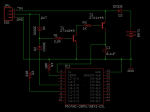I would use RGB leds (red, green, blue, all in one led) so some effects can be created, like red for when the IR is triggered, and perhaps blue to indicate a touch switch activated, etc.
Although this makes it a little harder to program, but still simple enough.
I am doubtful that the copper strip idea will work to detect objects on the shelf, and would expect a lot of work trying to make it work with getting the shelf to flex correctly under different weights, and what happens once the first object is placed on the shelf, it will render the contact strip useless for other objects.
I would scrap that idea before you waste hours on something that might not work.
As for flow chart programming, i have never used it and no intention of even trying it, Where the Basic text method is so simple to use and far more practical i think, and teaches you a lot more much faster, so if you use flow chart programming then i cant help.
Have you done any testing of parts yet?
You need to work through each part on their own and get each section working, then try to construct the full program from each tested section, its basically how we all construct a project and write our code to suit, or it will become a code mess with nothing working as intended.
What will power this, batteries, or what?
Although this makes it a little harder to program, but still simple enough.
I am doubtful that the copper strip idea will work to detect objects on the shelf, and would expect a lot of work trying to make it work with getting the shelf to flex correctly under different weights, and what happens once the first object is placed on the shelf, it will render the contact strip useless for other objects.
I would scrap that idea before you waste hours on something that might not work.
As for flow chart programming, i have never used it and no intention of even trying it, Where the Basic text method is so simple to use and far more practical i think, and teaches you a lot more much faster, so if you use flow chart programming then i cant help.
Have you done any testing of parts yet?
You need to work through each part on their own and get each section working, then try to construct the full program from each tested section, its basically how we all construct a project and write our code to suit, or it will become a code mess with nothing working as intended.
What will power this, batteries, or what?



